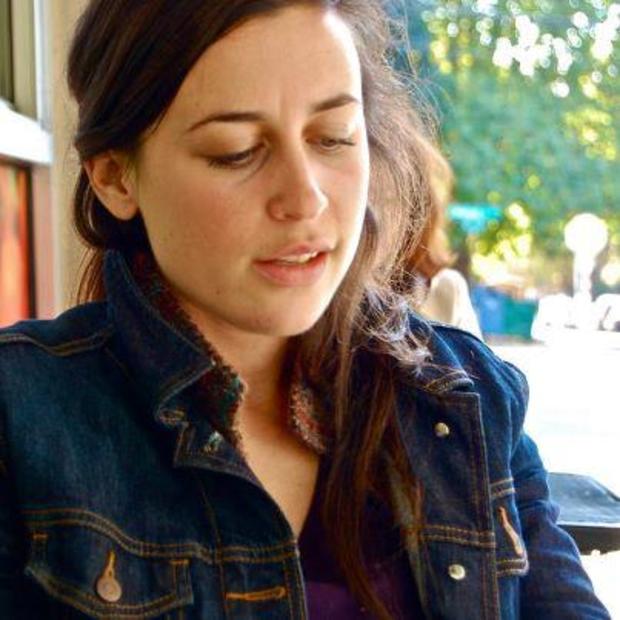In 2010, Alex Currier graduated from the University of Washington with a degree in philosophy and did the next most obvious thing for someone with his pedigree. Currier shipped off to Costa Rica to intern on a permaculture farm.
It was there that he was introduced to aquaponics — a synergetic system of agriculture that grows produce through an efficient feedback-loop between fish, plants and water. No soil required. The practice is rooted in ideas of permaculture, a guiding ecological agriculture system for survivalists, back-to-the-landers, environmental designers and food systems advocates.
Aquaponics 'raft' beds like the ones at the True Blue greenhouse in the Central District are two-tiered, allowing for vertical growing. Photo: Anna Goren
Currier, left on the farm with the beginnings of a large aquaponics system abandoned by a former farm manager, read over the plans for the system and began teach himself about the process. Fish waste, rich in plant nutrients and toxic to the fish that produce it, is pumped through a holding area for plants that sit on the top of the water. These plants use the nutrient-rich water to grow robust root systems, the process of which cleanses the water so that it can be returned to the fish. The process relies on structural design ingenuity and an understanding of how natural ecosystems function.
“It brought out the inner engineer in me,” says Currier.
Eventually, Currier made his way to a farm in Nicaragua, where Orcas Islander Doug Bullock was teaching a Permaculture Design Course [PDC].
Bullock, who, according to his website, puts the ‘cult’ in permaculture, has been teaching the PDC course on his Orcas homestead and at farms across the world for years, attracting permaculture enthusiasts from far and wide.
Less than a year after installing his first system in Nicaragua, Currier returned home to Seattle. Aside from a few personal backyard operations though, there was no one doing full-scale aquaponics within the city's already well-treaded urban agriculture path.
“It’s a totally decentralized system,” he says.
So, not long after returning from abroad, Currier founded True Blue Aquaponics, a company centering on consulting, education and the installation of aquaponics systems for food production in Seattle.
With the help of partners Charlie Wainger, Randy Styer and Andrew Long, True Blue acquired a small plot of land in the Central District. There, through a profit-sharing model with a willing landowner, a 20 by 40 ft. greenhouse now houses a full-scale aquaponics system. Out of the adjacent 2100 Building, a neighborhood community center, Currier teaches classes to the public about how to build their own systems for their house, urban farm or food operation.

Alex Currier in front of the aquaponics greenhouse at the Central City Farm Trust, at 24th and Walker. Photo: Anna Goren
“The intention is to get revenue from the company and re-direct it into urban projects,” says Currier, who wants to use other empty plots around the city to spread the aquaponics gospel. “This is underutilized land, but it’s productive.”
Aquaponics is an ideal growing system for urban environments: Unique in its capacity to produce high volumes of food in small spaces, it avoids typical soil-related urban agriculture problems, like lead contamination.
Currently, True Blue is focusing on installing aquaponics setups for clients and offering public workshops and consulting services.
 Looking forward though, the hope is that they will be able to expand their network of greenhouses in order to sell produce to local restaurants. Aquaponically-grown produce, Currier explains, actually lasts much longer. Since its exceptionally long roots are simply pulled from the water, rather than broken from the soil, produce is considered still alive when harvested.
Looking forward though, the hope is that they will be able to expand their network of greenhouses in order to sell produce to local restaurants. Aquaponically-grown produce, Currier explains, actually lasts much longer. Since its exceptionally long roots are simply pulled from the water, rather than broken from the soil, produce is considered still alive when harvested.Then there are the cost savings associated with buying food that doesn't need to be shipped across the state or the country.
Photo at right: Mustards, kale and lettuces grow easily by aquaponics because of their affinity for nitrogen, found in fish waste. Anna Goren.“I tested out a head of lettuce — it didn’t wilt for a week and a half,” exclaims Currier, who notes that large produce suppliers will often charge more for living plants, whereas they're standard for aquaponics farmers.
Though his path has been somewhat of a millenial cliche, Currier is more entrepreneur than ideologue hippie. Still, his bigger social and environmental ideas act as the driving force behind his business.
“The industrial agriculture sector has proven to be inefficient. I think the world is going to favor more localized food production, “ he says confidently.

